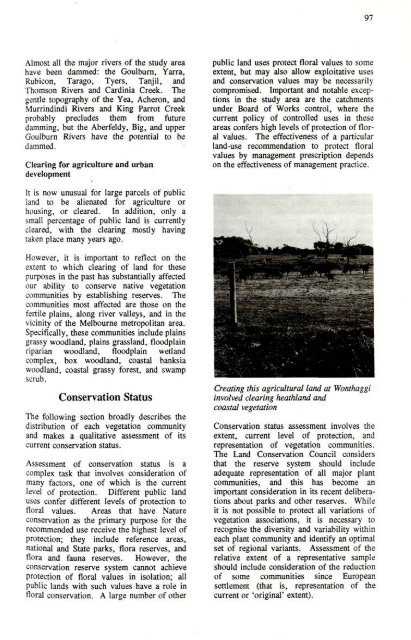Factors Affecting Flora Conservation - Victorian Environmental ...
Factors Affecting Flora Conservation - Victorian Environmental ...
Factors Affecting Flora Conservation - Victorian Environmental ...
Create successful ePaper yourself
Turn your PDF publications into a flip-book with our unique Google optimized e-Paper software.
97<br />
Almost all the major rivers of the study area<br />
have been dammed: the Goulbum, Yarra,<br />
Rubicon, Tarago, Tyers, Tanj ii, and<br />
Thomson Rivers and Cardinia Creek. The<br />
genfle topography of the Yea, Acheron, and<br />
Murrindindi Rivers and King Parrot Creek<br />
probably precludes them from future<br />
damming, but the Aberfeldy, Big, and upper<br />
Goulburn Rivers have the potential to be<br />
dammed.<br />
Clearing for agriculture and urban<br />
development<br />
public land uses protect floral values to some<br />
extent, but may also allow exploitative uses<br />
and conservation values may be necessarily<br />
compromised. Important and notable exceptions<br />
in the study area are the catchments<br />
under Board of Works control, where the<br />
current policy of controlled uses in these<br />
areas confers high levels of protection of floral<br />
values. The effectiveness of a particular<br />
land-use recommendation to protect fioral<br />
values by management prescription depends<br />
on the effectiveness of management practice.<br />
It is now unusual for large parcels of public<br />
land to be alienated for agriculture or<br />
housing, or cleared. In addition, only a<br />
small percentage of public land is currenfly<br />
cleared, with the clearing mosfly having<br />
taken place many years ago.<br />
However, it is important to reflect on the<br />
extent to which clearing of land for these<br />
purposes in the past has substanfially aff'ected<br />
our ability to conserve native vegetation<br />
communities by establishing reserves. The<br />
communities most affected are those on the<br />
fertile plains, along river valleys, and in the<br />
vicinity of the Melbourne metropolitan area.<br />
Specifically, these communities include plains<br />
grassy woodland, plains grassland, floodplain<br />
riparian woodland, floodplain wetland<br />
complex, box woodland, coastal banksia<br />
woodland, coastal grassy forest, and swamp<br />
scrub.<br />
<strong>Conservation</strong> Status<br />
The following section broadly describes the<br />
distribution of each vegetation community<br />
and makes a qualitative assessment of its<br />
current conservation status.<br />
Assessment of conservation status is a<br />
complex task that involves consideration of<br />
many factors, one of which is the current<br />
level of protection. Different public land<br />
uses confer different levels of protecfion to<br />
floral values. Areas that have Nature<br />
conservation as the primary purpose for the<br />
recommended use receive the highest level of<br />
protection; they include reference areas,<br />
national and State parks, flora reserves, and<br />
flora and fauna reserves. However, the<br />
conservation reserve system cannot achieve<br />
protection of floral values in isolation; all<br />
public lands with such values have a role in<br />
floral conservation. A large number of other<br />
Creating this agricultural land at Wonthaggi<br />
involved clearing heathland and<br />
coastal vegetation<br />
<strong>Conservation</strong> status assessment involves the<br />
extent, current level of protection, and<br />
representation of vegetation communities.<br />
The Land <strong>Conservation</strong> Council considers<br />
that the reserve system should include<br />
adequate representation of all major plant<br />
communities, and this has become an<br />
important considerafion in its recent deliberations<br />
about parks and other reserves. WTiile<br />
it is not possible to protect all variafions of<br />
vegetation associations, it is necessary to<br />
recognise the diversity and variability within<br />
each plant community and identify an optimal<br />
set of regional variants. Assessment of the<br />
relative extent of a representafive sample<br />
should include consideration of the reduction<br />
of some communities since European<br />
setflement (that is, representation of the<br />
current or 'original' extent).
















